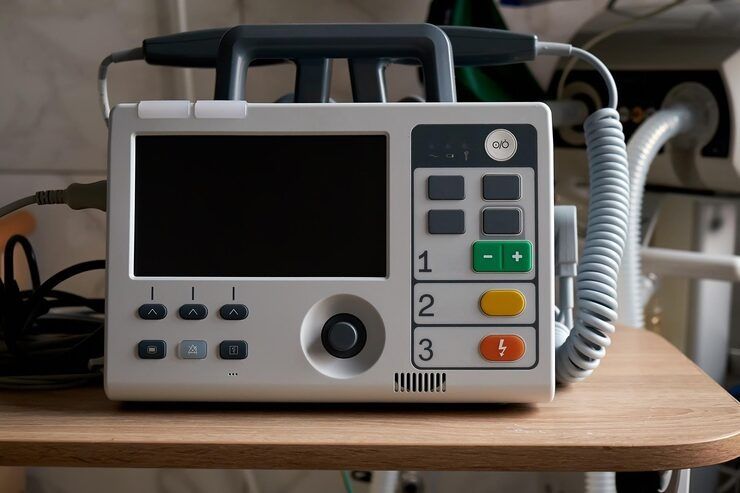Defibrillator machines are medical devices designed to deliver a controlled electric shock to the heart in cases of sudden cardiac arrest or life-threatening arrhythmias. The primary goal is to restore a normal heart rhythm when the heart stops beating effectively.
Importance
Cardiac arrest remains a leading global health concern, and defibrillators play a critical role in increasing survival chances. The importance of these machines can be understood through several key points:

-
Life-saving potential: Defibrillators can restore normal rhythm within minutes, making early access vital.
-
Accessibility: Portable AEDs have made lifesaving interventions available in public settings such as airports, schools, gyms, and offices.
-
Ease of use: Automated prompts and visual cues make AEDs operable by bystanders with minimal training.
-
Public health impact: Widespread deployment of defibrillators has significantly improved survival rates from out-of-hospital cardiac arrests.
In short, defibrillators bridge the gap between sudden collapse and advanced medical treatment, offering critical support when every second counts.
Recent Updates
Over the past year, several developments have shaped the defibrillator landscape:
-
AI integration (2023–2024): Advanced AEDs now feature artificial intelligence to analyze heart rhythms more accurately, reducing the chance of unnecessary shocks.
-
Remote monitoring: Connected defibrillators provide alerts to healthcare teams regarding readiness, battery levels, and electrode pad conditions.
-
Public access programs: Cities in the U.S., Europe, and Asia have expanded community defibrillator initiatives, placing AEDs in public spaces for faster emergency response.
-
Regulatory advancements: New guidelines from the American Heart Association (2023) emphasized rapid AED deployment within the first three minutes of cardiac arrest.
-
Compact design innovations: Portable and lighter models have been introduced, making them easier to store and transport.
These updates highlight ongoing efforts to improve accessibility, reliability, and effectiveness in emergency cardiac care.
Laws or Policies
Defibrillator use is often guided by national and regional policies:
-
Public access defibrillation laws: Many countries, including the U.S., Japan, and EU member states, require AEDs in airports, schools, sports facilities, and government buildings.
-
Good Samaritan laws: These laws protect individuals who use defibrillators in good faith during emergencies from legal liability.
-
Certification standards: Devices must comply with regulations from agencies such as the FDA (U.S.) or CE marking (Europe) to ensure safety and reliability.
-
Workplace safety rules: In some regions, occupational safety bodies recommend or mandate AEDs in workplaces with high employee counts.
-
Training requirements: Certain countries encourage or require CPR and AED training in schools and workplaces as part of public health initiatives.
These policies ensure that defibrillators are safe, reliable, and widely available to the public.
Tools and Resources
Several tools and resources are available for understanding and managing defibrillator machines:
-
AED locator apps: Applications like PulsePoint and Staying Alive help users find nearby AEDs during emergencies.
-
Training programs: Online and offline CPR and AED training courses offered by organizations like the American Red Cross or European Resuscitation Council.
-
Maintenance checklists: Digital tools for tracking battery status, pad expiration, and device readiness.
-
Guideline repositories: Websites of the American Heart Association and World Health Organization provide updated resuscitation guidelines.
-
Simulation tools: Mobile apps and VR-based training platforms allow practice in simulated emergency situations.
Example Table: Types of Defibrillators
| Type of Defibrillator | Primary Use | Key Feature |
|---|---|---|
| Automated External Defibrillator (AED) | Public and workplace emergencies | Voice-guided instructions |
| Manual Defibrillator | Hospitals, ambulances, advanced care | Used by trained professionals |
| Wearable Defibrillator | Patients at high risk | Continuous monitoring and response |
| Implantable Cardioverter Defibrillator (ICD) | Chronic cardiac patients | Implanted for long-term protection |
This breakdown shows how different defibrillators serve unique needs across emergency and long-term care scenarios.
FAQs
What is the purpose of a defibrillator?
A defibrillator delivers an electric shock to the heart to restore normal rhythm during cardiac arrest or arrhythmia.
Can anyone use an AED?
Yes. AEDs are designed for use by laypersons with minimal or no training. They provide clear voice and visual prompts to guide users through each step.
Are defibrillators safe to use?
Yes, when used as instructed. Modern devices are designed to assess heart rhythm and only deliver shocks when necessary.
Where are defibrillators commonly found?
They are placed in airports, schools, shopping malls, gyms, offices, ambulances, hospitals, and other public spaces.
Do defibrillators require regular maintenance?
Yes. Routine checks include monitoring battery life, electrode pad expiration, and device readiness indicators.
Conclusion
Defibrillator machines represent one of the most important advancements in emergency healthcare. From hospitals to public spaces, their presence ensures immediate intervention during life-threatening cardiac events. Recent developments, including AI integration and remote monitoring, demonstrate how technology continues to improve accessibility and reliability.
Supported by global laws, policies, and training programs, defibrillators are becoming an essential part of community safety strategies. Understanding their purpose, functionality, and safe use helps individuals and organizations play an active role in saving lives.
As awareness and accessibility grow, defibrillators will remain a cornerstone in the fight against sudden cardiac arrest worldwide.